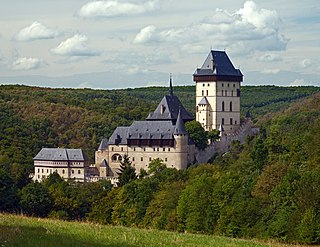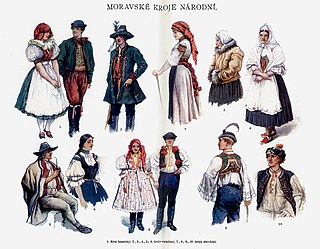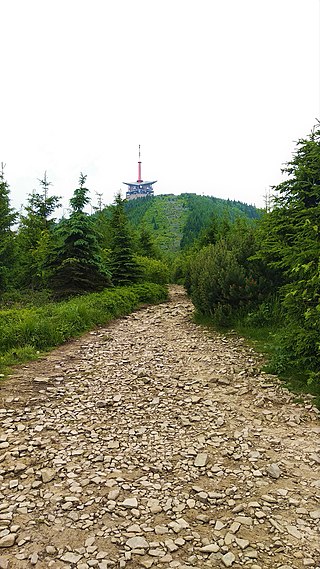
Bohemia is the westernmost and largest historical region of the Czech Republic. Bohemia can also refer to a wider area consisting of the historical Lands of the Bohemian Crown ruled by the Bohemian kings, including Moravia and Czech Silesia, in which case the smaller region is referred to as Bohemia proper as a means of distinction.

Moravia is a historical region in the east of the Czech Republic and one of three historical Czech lands, with Bohemia and Czech Silesia.

Upper Silesia is the southeastern part of the historical and geographical region of Silesia, located today mostly in Poland, with small parts in the Czech Republic. The area is predominantly known for its heavy industry.

Opava is a city in the Moravian-Silesian Region of the Czech Republic. It has about 56,000 inhabitants. It lies on the Opava River. Opava is one of the historical centres of Silesia. It was a historical capital of Czech Silesia.

Moravians are a West Slavic ethnographic group from the Moravia region of the Czech Republic, who speak the Moravian dialects of Czech or Common Czech or a mixed form of both. Along with the Silesians of the Czech Republic, a part of the population to identify ethnically as Moravian has registered in Czech censuses since 1991. The figure has fluctuated and in the 2011 census, 6.01% of the Czech population declared Moravian as their ethnicity. Smaller pockets of people declaring Moravian ethnicity are also native to neighboring Slovakia.
Silesian, Silesian German or Lower Silesian is a nearly extinct German dialect spoken in Silesia. It is part of the East Central German language area with some West Slavic and Lechitic influences. Silesian German emerged as the result of Late Medieval German migration to Silesia, which had been inhabited by Lechitic or West Slavic peoples in the Early Middle Ages.

The Moravian-Silesian Region is one of the 14 administrative regions of the Czech Republic. Before May 2001, it was called the Ostrava Region. The region is located in the north-eastern part of its historical region of Moravia and in most of the Czech part of the historical region of Silesia. The region borders the Olomouc Region to the west and the Zlín Region to the south. It also borders two other countries – Poland to the north and Slovakia to the east.

Hlučín is a town in Opava District the Moravian-Silesian Region of the Czech Republic. It has about 13,000 inhabitants. It was the centre of the historic Hlučín Region. The historic town centre is well preserved and is protected by law as an urban monument zone.

Czech Silesia is the part of the historical region of Silesia now in the Czech Republic. Czech Silesia is, together with Bohemia and Moravia, one of the three historical Czech lands.

Austrian Silesia, officially the Duchy of Upper and Lower Silesia, was an autonomous region of the Kingdom of Bohemia and the Habsburg monarchy. It is largely coterminous with the present-day region of Czech Silesia and was, historically, part of the larger Silesia region.

The Cieszyn Silesian dialect or Teschen Silesian dialect is one of the Silesian dialects. It has its roots mainly in Old Polish and also has strong influences from Czech and German and, to a lesser extent, from Vlach and Slovak. It is spoken in Cieszyn Silesia, a region on both sides of the Polish-Czech border. It remains mostly a spoken language. The dialect is better preserved today than traditional dialects of many other West Slavic regions.

Moravian Wallachia is a mountainous ethnoregion located in the easternmost part of Moravia in the Czech Republic, near the Slovak border, roughly centered on the cities Vsetín, Valašské Meziříčí and Rožnov pod Radhoštěm. The name Wallachia used to be applied to all the highlands of Moravia and the neighboring Silesia, although in the 19th century a smaller area came to be defined as ethno-cultural Moravian Wallachia. The traditional dialect represents a mixture of elements from the Czech and Slovak languages, and has a distinct lexicon of Romanian origin relating to the pastoral economy of the highlands. The name originated from the term "Vlach", the exonym of Romanians.

Vrbno pod Pradědem is a town in Bruntál District in the Moravian-Silesian Region of the Czech Republic. It has about 4,800 inhabitants.
Silesian as an adjective can mean anything from or related to Silesia. As a noun, it refers to an article, item, or person of or from Silesia.

The Province of German Bohemia was a province in Bohemia, now the Czech Republic, established for a short period of time after the First World War, as part of the Republic of German-Austria.

Kevin J. Hannan was an American ethnolinguist and slavicist.

Moravian dialects are the varieties of Czech spoken in Moravia, a historical region in the east of the Czech Republic. There are more forms of the Czech language used in Moravia than in the rest of the Czech Republic. The main four groups of dialects are the Bohemian-Moravian group, the Central Moravian group, the Eastern Moravian group and the Lach (Silesian) group. While the forms are generally viewed as regional variants of Czech, some Moravians claim them to be one separate Moravian language.

Dětřichov nad Bystřicí is a municipality and village in Bruntál District in the Moravian-Silesian Region of the Czech Republic. It has about 400 inhabitants.

Józef Kożdoń was Silesian autonomist politician.

The Moravice is a river in the Czech Republic, a right tributary of the Opava River. It flows through the Moravian-Silesian Region. It is 100.5 km (62.4 mi) long, which makes it the 25th longest river in the Czech Republic.


















